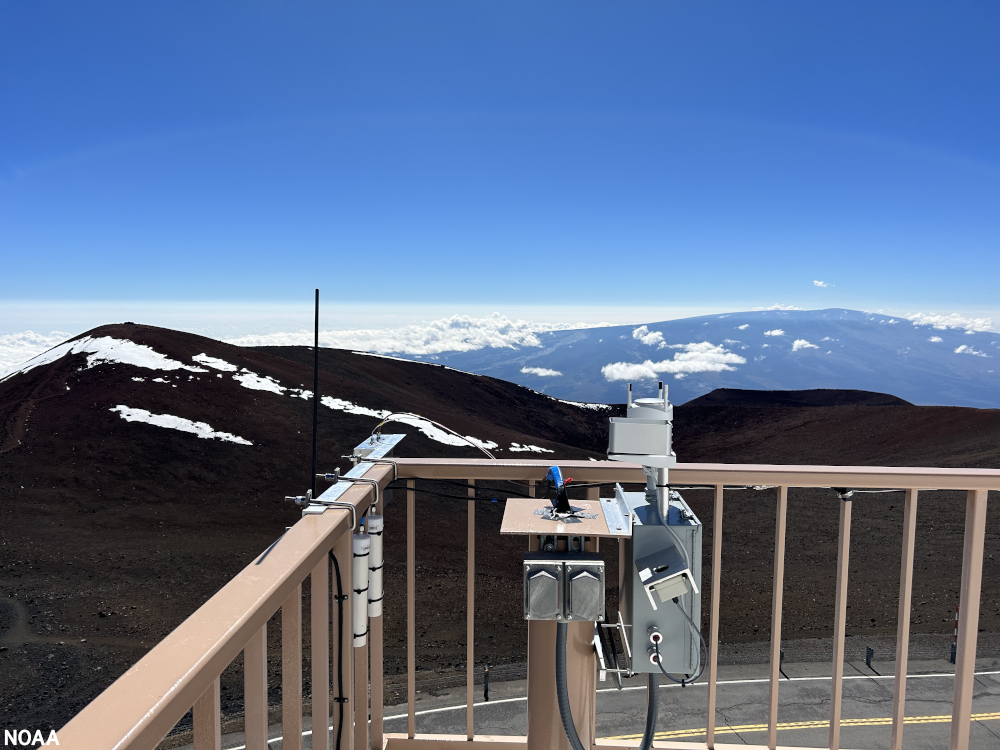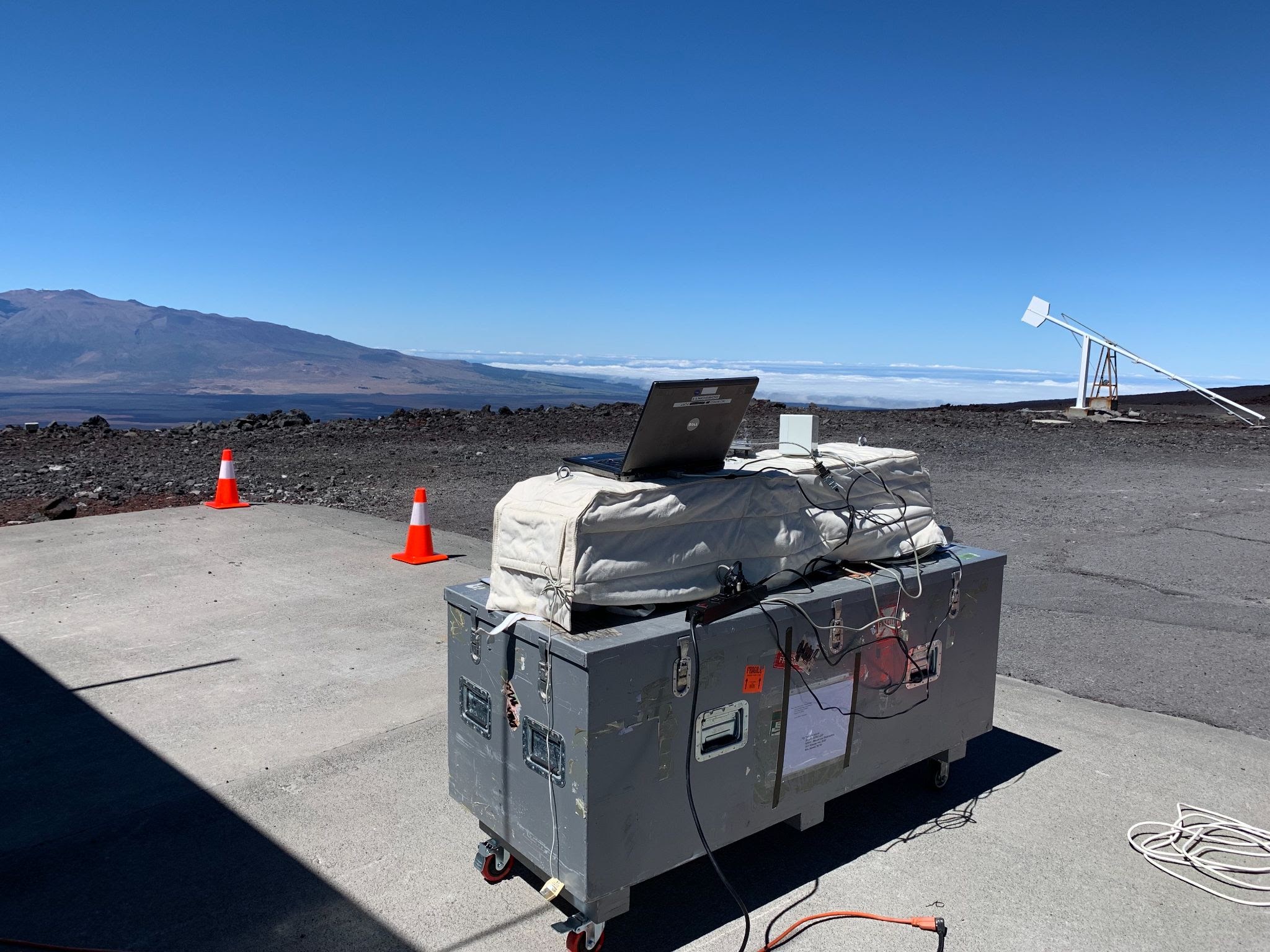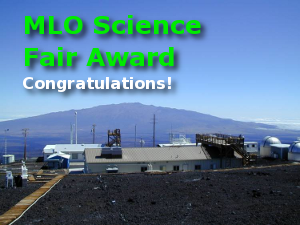More than two years after road access and electrical power to the Mauna Loa Observatory was cut off by lava flows, NOAA staff continue to make critical measurements of the atmosphere and other environmental variables at the remote site.
In 2023, observatory staff installed solar panels at the site and resumed some measurements, including the independent carbon dioxide monitoring programs run by the Global Monitoring Laboratory and Scripps Institution of Oceanography, as well as other atmospheric measurements.
Construction of a temporary road to access the observatory site is anticipated to begin in summer 2025.
Media can contact: Theo Stein (303) 819-7409 (theo.stein@noaa.gov)
News

During a year of extremes, carbon dioxide levels surge faster than ever
Carbon dioxide is accumulating in the atmosphere faster than ever — accelerating on a steep rise to levels far above any experienced during human existence, scientists from NOAA and the Scripps Institution of Oceanography offsite link at the University of California San Diego announced todayHaving dodged lava flows, NOAA's Mauna Loa research facility to get upgrades
NOAA’s Mauna Loa Atmospheric Baseline Observatory, the benchmark sampling site for monitoring global climate change, is slated to undergo a major renovation and facility upgrade once road access is restored over lava flows produced by the recent eruption of Mauna Loa volcano.University of Hawaii, NOAA to gather climate change data following Mauna Loa eruption
NOAA will partner with the University of Hawaii (UH) to collect atmospheric measurements at the Mauna Kea Observatories on the Big Island of Hawaii.Carbon dioxide now more than 50% higher than pre-industrial levels
Carbon dioxide measured at NOAA’s Mauna Loa Atmospheric Baseline Observatory peaked for 2022 at 421 parts per million in May, pushing the atmosphere further into territory not seen for millions of years.Keeping up the standard: Calibrating for accurate ozone monitoring
GML scientist Glen McConville and Lapenta intern Leah Barkai started the calibration of Dobson World standard instrument D083 at the GML Mauna Loa Observatory on July 12, 2021, and will continue the calibration until the end of August.Carbon dioxide peaks near 420 parts per million at Mauna Loa observatory
Atmospheric carbon dioxide measured at NOAA’s Mauna Loa Atmospheric Baseline Observatory peaked for 2021 in May at a monthly average of 419 parts per million (ppm), the highest level since accurate measurements began 63 years ago, scientists from NOAA and Scripps Institution of Oceanography at the University of California San Diego announced today.Rise of carbon dioxide unabated
Seasonal peak reaches 417 parts per million at Mauna Loa observatoryCarbon dioxide levels hit record peak in May
Atmospheric carbon dioxide continued its rapid rise in 2019, with the average for May peaking at 414.7 parts per million at NOAA’s Mauna Loa Atmospheric Baseline Observatory, scientists from NOAA and Scripps Institution of Oceanography at the University of California San Diego announced today.Global carbon dioxide growth in 2018 reached 4th highest on record
By the end of 2018, NOAA’s atmospheric observatory at Mauna Loa recorded the fourth-highest annual growth in the concentration of atmospheric carbon dioxide (CO2) in 60 years of record-keeping.Another climate milestone on Mauna Loa
Carbon dioxide levels measured at NOAA’s Mauna Loa Atmospheric Baseline Observatory averaged more than 410 parts per million in April and May, the highest monthly averages ever recorded, scientists from NOAA and Scripps Institution of Oceanography at the University of California San Diego announced today.Carbon dioxide levels rose at record pace for 2nd straight year
Carbon dioxide levels measured at NOAA’s Mauna Loa Baseline Atmospheric Observatory rose by 3 parts per million to 405.1 parts per million (ppm) in 2016, an increase that matched the record jump observed in 2015.2015 State of the Climate: Carbon Dioxide
Using measurements taken worldwide, scientists estimated that 2015’s global average carbon dioxide concentration was 399.4 parts per million (ppm), a new record high. At Mauna Loa Observatory in Hawai’i, where atmospheric carbon dioxide has been recorded longer than anywhere else in the world, the annual average carbon dioxide concentration was 400.8—also a new record, and a new milestone.MLO Science Fair Awards
Every year MLO contributes to the local Science Fair event. This year Samantha Yamamoto & Maile Birlhante won the junior research award with their project 'Light Dispersing'. Kendra Puleo won the second award with 'Ocean acidification effect on the food chain.' Kylan K. Sakata won the senior division award with 'Verifying special relativity over time dilation through moon decay at variable altitudes' and Moana Lily Pinner won the second award with 'Investigating the SPF, anti-oxidant and anti cancer potential of turmeric and ginger.'Record annual increase of carbon dioxide observed at Mauna Loa for 2015
The annual growth rate of atmospheric carbon dioxide measured at NOAA’s Mauna Loa Observatory in Hawaii jumped by 3.05 parts per million during 2015, the largest year-to-year increase in 56 years of research.MLO Science Fair Awards
Every year the Mauna Loa Obervatory contributes to the local Science Fair event. This year, Halia Buchal won the junior research award with the project titled: Purple or Green? Does Leaf Color Affect How Plants Respond to Different Colors of Light? The Senior research recipent Keanu D. Pinner won the senior division award with the project titled: Activation of the Hepatocyte Antioxidant Response by Kava Secondary Metabolites.

.png?h=bd90e97c&itok=b353ke6f)










